Australian Financial Reporting Regulations: A Critical Review - HI6025
VerifiedAdded on 2023/01/11
|14
|3970
|80
Report
AI Summary
This report delves into accounting theory, specifically focusing on Australian financial reporting regulations and current issues. It begins with an introduction to accounting theory, its frameworks, and methodologies. The report then examines the Australian financial reporting environment, including disclosure requirements and regulations for different types of entities. It analyzes the regulatory bodies and standards, such as the Australian Accounting Standards Board (AASB) and the International Financial Reporting Standards (IFRS). The core of the report involves a critical review of a chosen accounting fraud case, including key facts, violations of accounting regulations, and an analysis of how Positive Accounting Theory (PAT) might have predicted the actions of the parties involved. The report also explores the lessons learned from the fraud and concludes with recommendations for future directions in Australian financial reporting. The report highlights the importance of accurate financial reporting and the impact of regulations on investor confidence and market integrity. Finally, the report includes an analysis of several accounting regulations that were violated in the chosen case, such as rent rises, depreciation, labor cost capitalization, accrued holiday/paid time off, and unknown tax points.
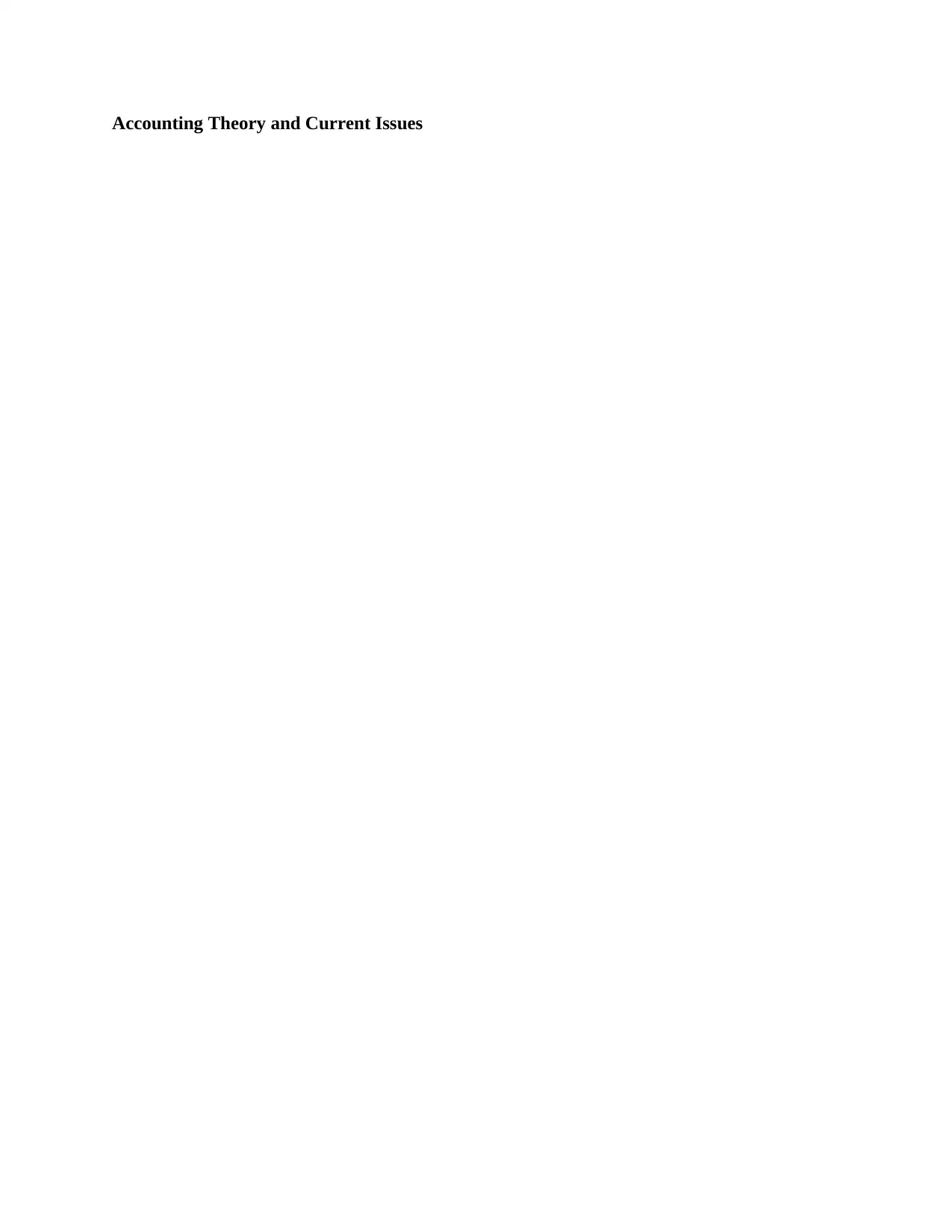
Accounting Theory and Current Issues
Paraphrase This Document
Need a fresh take? Get an instant paraphrase of this document with our AI Paraphraser
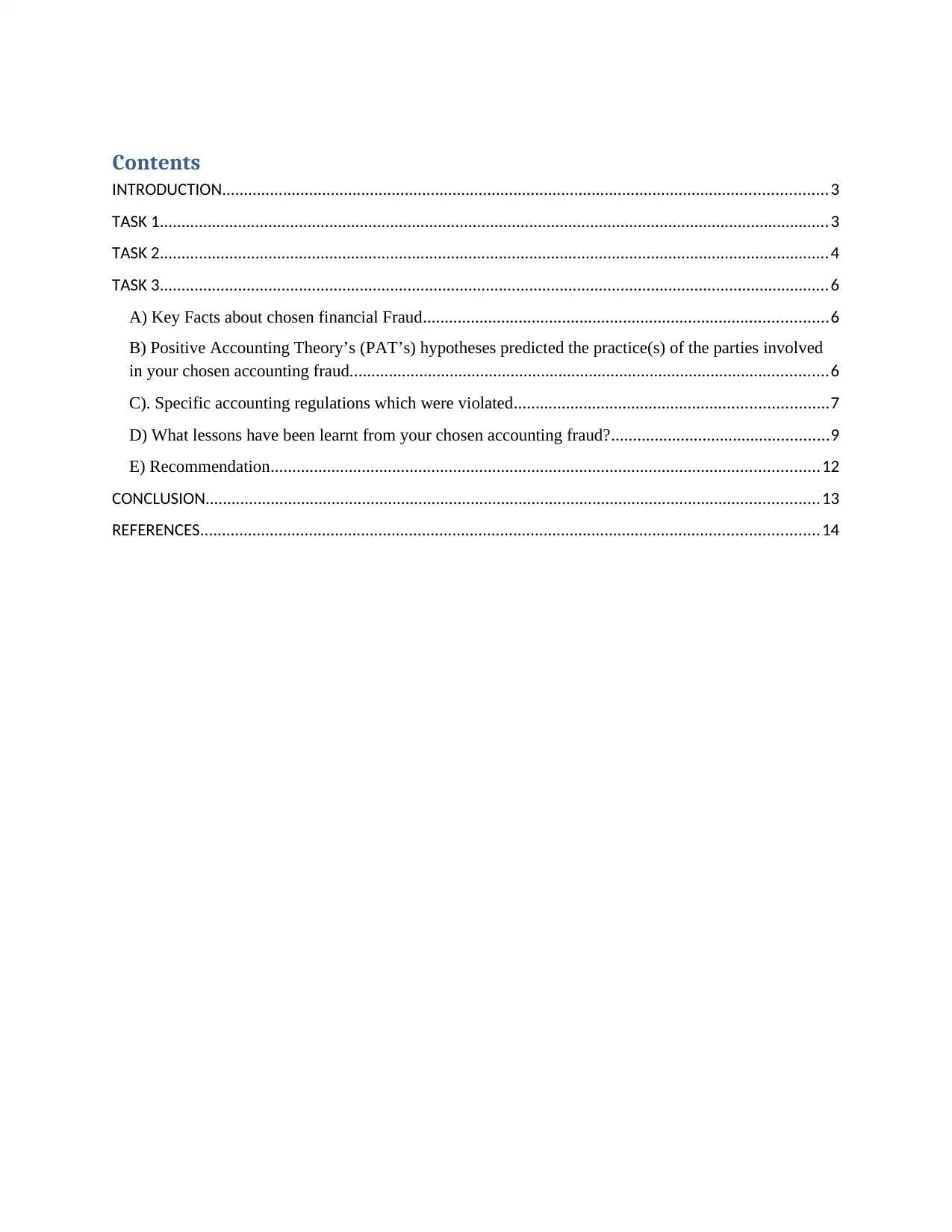
Contents
INTRODUCTION...........................................................................................................................................3
TASK 1..........................................................................................................................................................3
TASK 2..........................................................................................................................................................4
TASK 3..........................................................................................................................................................6
A) Key Facts about chosen financial Fraud.............................................................................................6
B) Positive Accounting Theory’s (PAT’s) hypotheses predicted the practice(s) of the parties involved
in your chosen accounting fraud..............................................................................................................6
C). Specific accounting regulations which were violated........................................................................7
D) What lessons have been learnt from your chosen accounting fraud?..................................................9
E) Recommendation..............................................................................................................................12
CONCLUSION.............................................................................................................................................13
REFERENCES..............................................................................................................................................14
INTRODUCTION...........................................................................................................................................3
TASK 1..........................................................................................................................................................3
TASK 2..........................................................................................................................................................4
TASK 3..........................................................................................................................................................6
A) Key Facts about chosen financial Fraud.............................................................................................6
B) Positive Accounting Theory’s (PAT’s) hypotheses predicted the practice(s) of the parties involved
in your chosen accounting fraud..............................................................................................................6
C). Specific accounting regulations which were violated........................................................................7
D) What lessons have been learnt from your chosen accounting fraud?..................................................9
E) Recommendation..............................................................................................................................12
CONCLUSION.............................................................................................................................................13
REFERENCES..............................................................................................................................................14
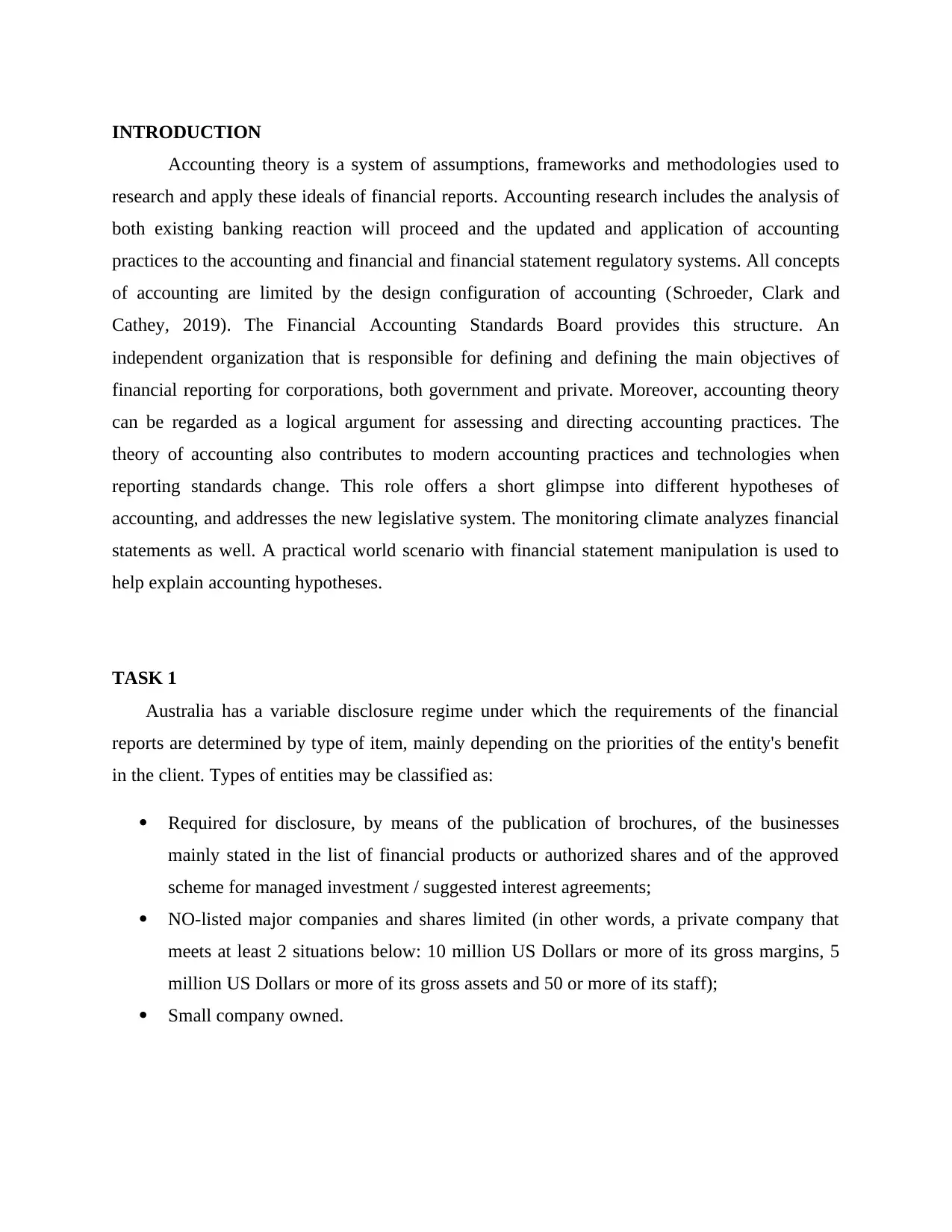
INTRODUCTION
Accounting theory is a system of assumptions, frameworks and methodologies used to
research and apply these ideals of financial reports. Accounting research includes the analysis of
both existing banking reaction will proceed and the updated and application of accounting
practices to the accounting and financial and financial statement regulatory systems. All concepts
of accounting are limited by the design configuration of accounting (Schroeder, Clark and
Cathey, 2019). The Financial Accounting Standards Board provides this structure. An
independent organization that is responsible for defining and defining the main objectives of
financial reporting for corporations, both government and private. Moreover, accounting theory
can be regarded as a logical argument for assessing and directing accounting practices. The
theory of accounting also contributes to modern accounting practices and technologies when
reporting standards change. This role offers a short glimpse into different hypotheses of
accounting, and addresses the new legislative system. The monitoring climate analyzes financial
statements as well. A practical world scenario with financial statement manipulation is used to
help explain accounting hypotheses.
TASK 1
Australia has a variable disclosure regime under which the requirements of the financial
reports are determined by type of item, mainly depending on the priorities of the entity's benefit
in the client. Types of entities may be classified as:
Required for disclosure, by means of the publication of brochures, of the businesses
mainly stated in the list of financial products or authorized shares and of the approved
scheme for managed investment / suggested interest agreements;
NO-listed major companies and shares limited (in other words, a private company that
meets at least 2 situations below: 10 million US Dollars or more of its gross margins, 5
million US Dollars or more of its gross assets and 50 or more of its staff);
Small company owned.
Accounting theory is a system of assumptions, frameworks and methodologies used to
research and apply these ideals of financial reports. Accounting research includes the analysis of
both existing banking reaction will proceed and the updated and application of accounting
practices to the accounting and financial and financial statement regulatory systems. All concepts
of accounting are limited by the design configuration of accounting (Schroeder, Clark and
Cathey, 2019). The Financial Accounting Standards Board provides this structure. An
independent organization that is responsible for defining and defining the main objectives of
financial reporting for corporations, both government and private. Moreover, accounting theory
can be regarded as a logical argument for assessing and directing accounting practices. The
theory of accounting also contributes to modern accounting practices and technologies when
reporting standards change. This role offers a short glimpse into different hypotheses of
accounting, and addresses the new legislative system. The monitoring climate analyzes financial
statements as well. A practical world scenario with financial statement manipulation is used to
help explain accounting hypotheses.
TASK 1
Australia has a variable disclosure regime under which the requirements of the financial
reports are determined by type of item, mainly depending on the priorities of the entity's benefit
in the client. Types of entities may be classified as:
Required for disclosure, by means of the publication of brochures, of the businesses
mainly stated in the list of financial products or authorized shares and of the approved
scheme for managed investment / suggested interest agreements;
NO-listed major companies and shares limited (in other words, a private company that
meets at least 2 situations below: 10 million US Dollars or more of its gross margins, 5
million US Dollars or more of its gross assets and 50 or more of its staff);
Small company owned.
⊘ This is a preview!⊘
Do you want full access?
Subscribe today to unlock all pages.

Trusted by 1+ million students worldwide
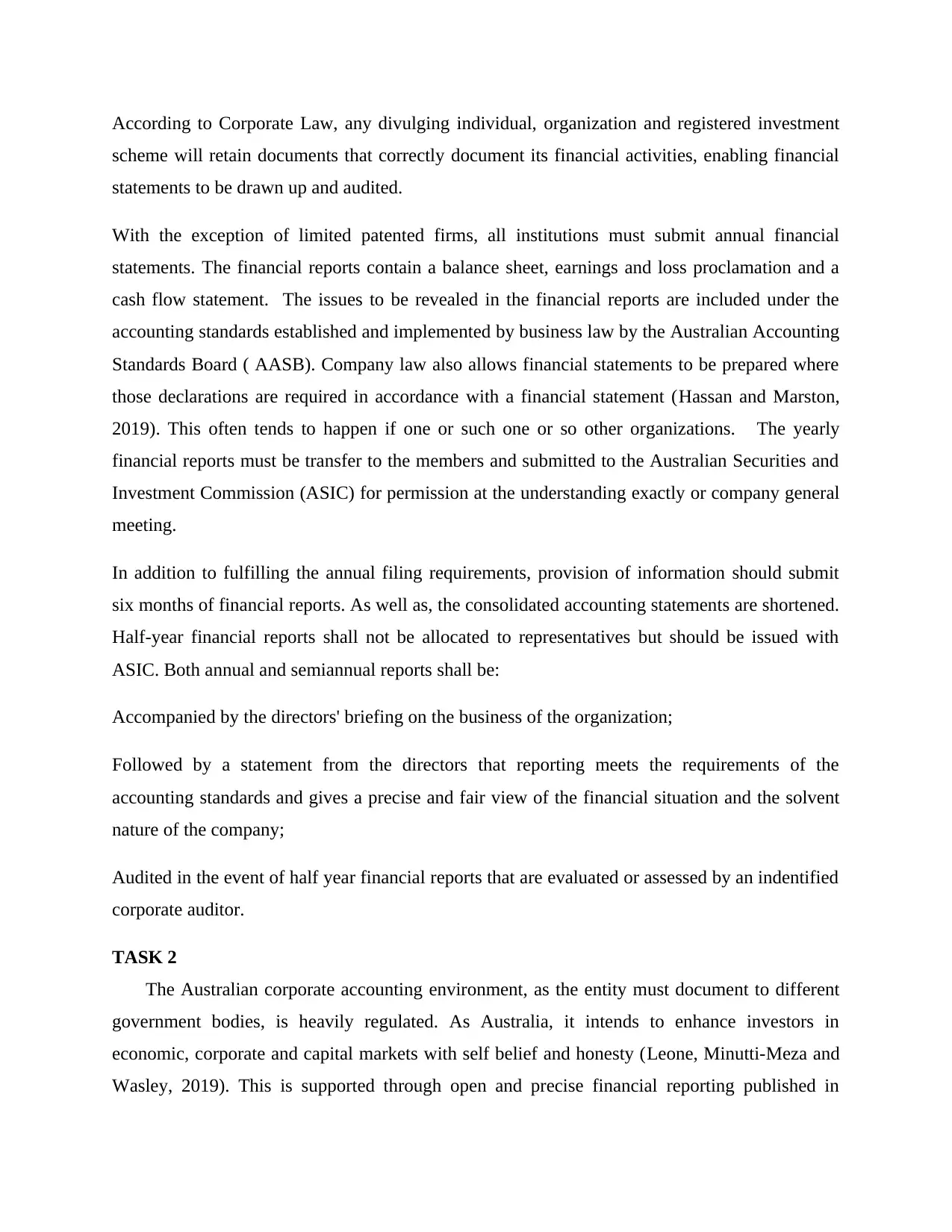
According to Corporate Law, any divulging individual, organization and registered investment
scheme will retain documents that correctly document its financial activities, enabling financial
statements to be drawn up and audited.
With the exception of limited patented firms, all institutions must submit annual financial
statements. The financial reports contain a balance sheet, earnings and loss proclamation and a
cash flow statement. The issues to be revealed in the financial reports are included under the
accounting standards established and implemented by business law by the Australian Accounting
Standards Board ( AASB). Company law also allows financial statements to be prepared where
those declarations are required in accordance with a financial statement (Hassan and Marston,
2019). This often tends to happen if one or such one or so other organizations. The yearly
financial reports must be transfer to the members and submitted to the Australian Securities and
Investment Commission (ASIC) for permission at the understanding exactly or company general
meeting.
In addition to fulfilling the annual filing requirements, provision of information should submit
six months of financial reports. As well as, the consolidated accounting statements are shortened.
Half-year financial reports shall not be allocated to representatives but should be issued with
ASIC. Both annual and semiannual reports shall be:
Accompanied by the directors' briefing on the business of the organization;
Followed by a statement from the directors that reporting meets the requirements of the
accounting standards and gives a precise and fair view of the financial situation and the solvent
nature of the company;
Audited in the event of half year financial reports that are evaluated or assessed by an indentified
corporate auditor.
TASK 2
The Australian corporate accounting environment, as the entity must document to different
government bodies, is heavily regulated. As Australia, it intends to enhance investors in
economic, corporate and capital markets with self belief and honesty (Leone, Minutti-Meza and
Wasley, 2019). This is supported through open and precise financial reporting published in
scheme will retain documents that correctly document its financial activities, enabling financial
statements to be drawn up and audited.
With the exception of limited patented firms, all institutions must submit annual financial
statements. The financial reports contain a balance sheet, earnings and loss proclamation and a
cash flow statement. The issues to be revealed in the financial reports are included under the
accounting standards established and implemented by business law by the Australian Accounting
Standards Board ( AASB). Company law also allows financial statements to be prepared where
those declarations are required in accordance with a financial statement (Hassan and Marston,
2019). This often tends to happen if one or such one or so other organizations. The yearly
financial reports must be transfer to the members and submitted to the Australian Securities and
Investment Commission (ASIC) for permission at the understanding exactly or company general
meeting.
In addition to fulfilling the annual filing requirements, provision of information should submit
six months of financial reports. As well as, the consolidated accounting statements are shortened.
Half-year financial reports shall not be allocated to representatives but should be issued with
ASIC. Both annual and semiannual reports shall be:
Accompanied by the directors' briefing on the business of the organization;
Followed by a statement from the directors that reporting meets the requirements of the
accounting standards and gives a precise and fair view of the financial situation and the solvent
nature of the company;
Audited in the event of half year financial reports that are evaluated or assessed by an indentified
corporate auditor.
TASK 2
The Australian corporate accounting environment, as the entity must document to different
government bodies, is heavily regulated. As Australia, it intends to enhance investors in
economic, corporate and capital markets with self belief and honesty (Leone, Minutti-Meza and
Wasley, 2019). This is supported through open and precise financial reporting published in
Paraphrase This Document
Need a fresh take? Get an instant paraphrase of this document with our AI Paraphraser
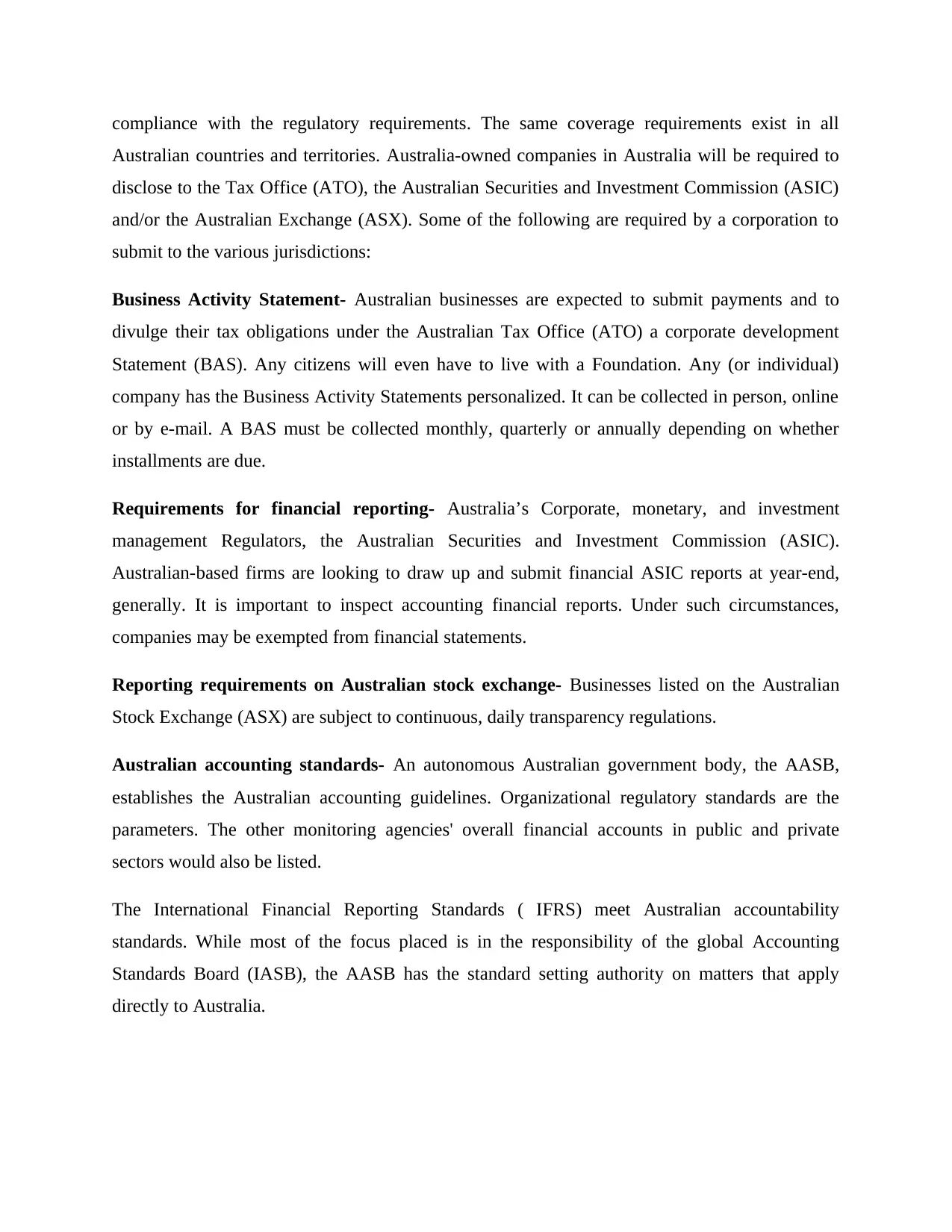
compliance with the regulatory requirements. The same coverage requirements exist in all
Australian countries and territories. Australia-owned companies in Australia will be required to
disclose to the Tax Office (ATO), the Australian Securities and Investment Commission (ASIC)
and/or the Australian Exchange (ASX). Some of the following are required by a corporation to
submit to the various jurisdictions:
Business Activity Statement- Australian businesses are expected to submit payments and to
divulge their tax obligations under the Australian Tax Office (ATO) a corporate development
Statement (BAS). Any citizens will even have to live with a Foundation. Any (or individual)
company has the Business Activity Statements personalized. It can be collected in person, online
or by e-mail. A BAS must be collected monthly, quarterly or annually depending on whether
installments are due.
Requirements for financial reporting- Australia’s Corporate, monetary, and investment
management Regulators, the Australian Securities and Investment Commission (ASIC).
Australian-based firms are looking to draw up and submit financial ASIC reports at year-end,
generally. It is important to inspect accounting financial reports. Under such circumstances,
companies may be exempted from financial statements.
Reporting requirements on Australian stock exchange- Businesses listed on the Australian
Stock Exchange (ASX) are subject to continuous, daily transparency regulations.
Australian accounting standards- An autonomous Australian government body, the AASB,
establishes the Australian accounting guidelines. Organizational regulatory standards are the
parameters. The other monitoring agencies' overall financial accounts in public and private
sectors would also be listed.
The International Financial Reporting Standards ( IFRS) meet Australian accountability
standards. While most of the focus placed is in the responsibility of the global Accounting
Standards Board (IASB), the AASB has the standard setting authority on matters that apply
directly to Australia.
Australian countries and territories. Australia-owned companies in Australia will be required to
disclose to the Tax Office (ATO), the Australian Securities and Investment Commission (ASIC)
and/or the Australian Exchange (ASX). Some of the following are required by a corporation to
submit to the various jurisdictions:
Business Activity Statement- Australian businesses are expected to submit payments and to
divulge their tax obligations under the Australian Tax Office (ATO) a corporate development
Statement (BAS). Any citizens will even have to live with a Foundation. Any (or individual)
company has the Business Activity Statements personalized. It can be collected in person, online
or by e-mail. A BAS must be collected monthly, quarterly or annually depending on whether
installments are due.
Requirements for financial reporting- Australia’s Corporate, monetary, and investment
management Regulators, the Australian Securities and Investment Commission (ASIC).
Australian-based firms are looking to draw up and submit financial ASIC reports at year-end,
generally. It is important to inspect accounting financial reports. Under such circumstances,
companies may be exempted from financial statements.
Reporting requirements on Australian stock exchange- Businesses listed on the Australian
Stock Exchange (ASX) are subject to continuous, daily transparency regulations.
Australian accounting standards- An autonomous Australian government body, the AASB,
establishes the Australian accounting guidelines. Organizational regulatory standards are the
parameters. The other monitoring agencies' overall financial accounts in public and private
sectors would also be listed.
The International Financial Reporting Standards ( IFRS) meet Australian accountability
standards. While most of the focus placed is in the responsibility of the global Accounting
Standards Board (IASB), the AASB has the standard setting authority on matters that apply
directly to Australia.
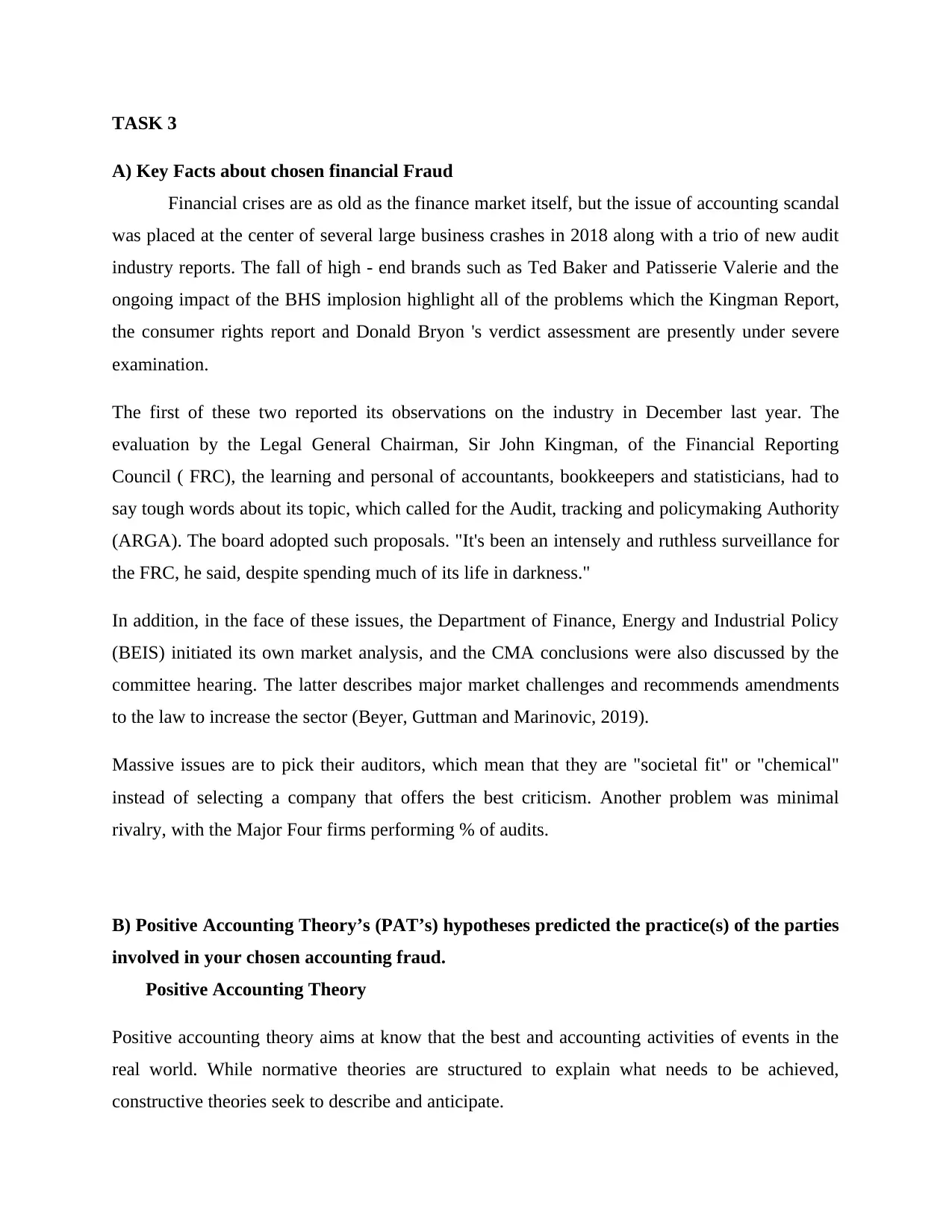
TASK 3
A) Key Facts about chosen financial Fraud
Financial crises are as old as the finance market itself, but the issue of accounting scandal
was placed at the center of several large business crashes in 2018 along with a trio of new audit
industry reports. The fall of high - end brands such as Ted Baker and Patisserie Valerie and the
ongoing impact of the BHS implosion highlight all of the problems which the Kingman Report,
the consumer rights report and Donald Bryon 's verdict assessment are presently under severe
examination.
The first of these two reported its observations on the industry in December last year. The
evaluation by the Legal General Chairman, Sir John Kingman, of the Financial Reporting
Council ( FRC), the learning and personal of accountants, bookkeepers and statisticians, had to
say tough words about its topic, which called for the Audit, tracking and policymaking Authority
(ARGA). The board adopted such proposals. "It's been an intensely and ruthless surveillance for
the FRC, he said, despite spending much of its life in darkness."
In addition, in the face of these issues, the Department of Finance, Energy and Industrial Policy
(BEIS) initiated its own market analysis, and the CMA conclusions were also discussed by the
committee hearing. The latter describes major market challenges and recommends amendments
to the law to increase the sector (Beyer, Guttman and Marinovic, 2019).
Massive issues are to pick their auditors, which mean that they are "societal fit" or "chemical"
instead of selecting a company that offers the best criticism. Another problem was minimal
rivalry, with the Major Four firms performing % of audits.
B) Positive Accounting Theory’s (PAT’s) hypotheses predicted the practice(s) of the parties
involved in your chosen accounting fraud.
Positive Accounting Theory
Positive accounting theory aims at know that the best and accounting activities of events in the
real world. While normative theories are structured to explain what needs to be achieved,
constructive theories seek to describe and anticipate.
A) Key Facts about chosen financial Fraud
Financial crises are as old as the finance market itself, but the issue of accounting scandal
was placed at the center of several large business crashes in 2018 along with a trio of new audit
industry reports. The fall of high - end brands such as Ted Baker and Patisserie Valerie and the
ongoing impact of the BHS implosion highlight all of the problems which the Kingman Report,
the consumer rights report and Donald Bryon 's verdict assessment are presently under severe
examination.
The first of these two reported its observations on the industry in December last year. The
evaluation by the Legal General Chairman, Sir John Kingman, of the Financial Reporting
Council ( FRC), the learning and personal of accountants, bookkeepers and statisticians, had to
say tough words about its topic, which called for the Audit, tracking and policymaking Authority
(ARGA). The board adopted such proposals. "It's been an intensely and ruthless surveillance for
the FRC, he said, despite spending much of its life in darkness."
In addition, in the face of these issues, the Department of Finance, Energy and Industrial Policy
(BEIS) initiated its own market analysis, and the CMA conclusions were also discussed by the
committee hearing. The latter describes major market challenges and recommends amendments
to the law to increase the sector (Beyer, Guttman and Marinovic, 2019).
Massive issues are to pick their auditors, which mean that they are "societal fit" or "chemical"
instead of selecting a company that offers the best criticism. Another problem was minimal
rivalry, with the Major Four firms performing % of audits.
B) Positive Accounting Theory’s (PAT’s) hypotheses predicted the practice(s) of the parties
involved in your chosen accounting fraud.
Positive Accounting Theory
Positive accounting theory aims at know that the best and accounting activities of events in the
real world. While normative theories are structured to explain what needs to be achieved,
constructive theories seek to describe and anticipate.
⊘ This is a preview!⊘
Do you want full access?
Subscribe today to unlock all pages.

Trusted by 1+ million students worldwide
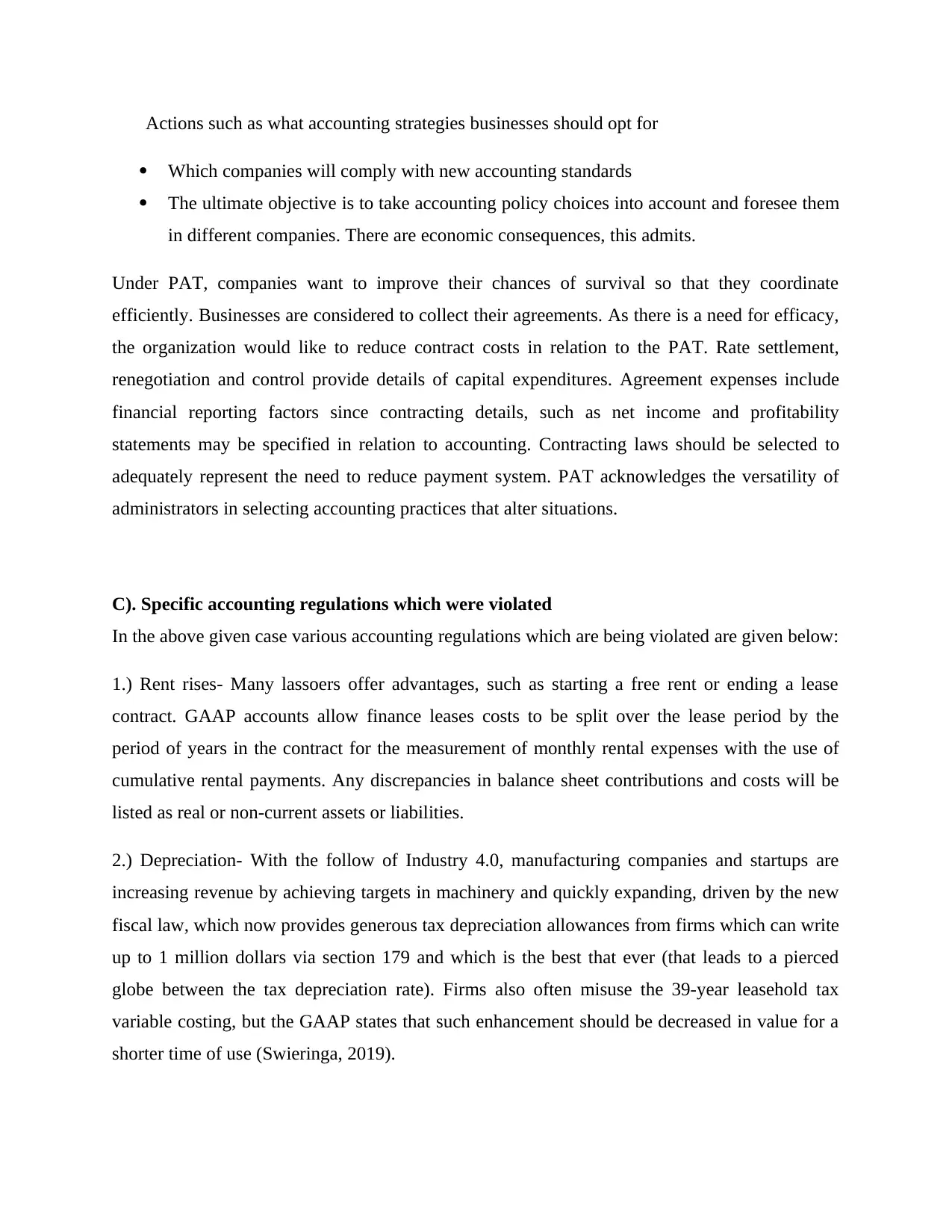
Actions such as what accounting strategies businesses should opt for
Which companies will comply with new accounting standards
The ultimate objective is to take accounting policy choices into account and foresee them
in different companies. There are economic consequences, this admits.
Under PAT, companies want to improve their chances of survival so that they coordinate
efficiently. Businesses are considered to collect their agreements. As there is a need for efficacy,
the organization would like to reduce contract costs in relation to the PAT. Rate settlement,
renegotiation and control provide details of capital expenditures. Agreement expenses include
financial reporting factors since contracting details, such as net income and profitability
statements may be specified in relation to accounting. Contracting laws should be selected to
adequately represent the need to reduce payment system. PAT acknowledges the versatility of
administrators in selecting accounting practices that alter situations.
C). Specific accounting regulations which were violated
In the above given case various accounting regulations which are being violated are given below:
1.) Rent rises- Many lassoers offer advantages, such as starting a free rent or ending a lease
contract. GAAP accounts allow finance leases costs to be split over the lease period by the
period of years in the contract for the measurement of monthly rental expenses with the use of
cumulative rental payments. Any discrepancies in balance sheet contributions and costs will be
listed as real or non-current assets or liabilities.
2.) Depreciation- With the follow of Industry 4.0, manufacturing companies and startups are
increasing revenue by achieving targets in machinery and quickly expanding, driven by the new
fiscal law, which now provides generous tax depreciation allowances from firms which can write
up to 1 million dollars via section 179 and which is the best that ever (that leads to a pierced
globe between the tax depreciation rate). Firms also often misuse the 39-year leasehold tax
variable costing, but the GAAP states that such enhancement should be decreased in value for a
shorter time of use (Swieringa, 2019).
Which companies will comply with new accounting standards
The ultimate objective is to take accounting policy choices into account and foresee them
in different companies. There are economic consequences, this admits.
Under PAT, companies want to improve their chances of survival so that they coordinate
efficiently. Businesses are considered to collect their agreements. As there is a need for efficacy,
the organization would like to reduce contract costs in relation to the PAT. Rate settlement,
renegotiation and control provide details of capital expenditures. Agreement expenses include
financial reporting factors since contracting details, such as net income and profitability
statements may be specified in relation to accounting. Contracting laws should be selected to
adequately represent the need to reduce payment system. PAT acknowledges the versatility of
administrators in selecting accounting practices that alter situations.
C). Specific accounting regulations which were violated
In the above given case various accounting regulations which are being violated are given below:
1.) Rent rises- Many lassoers offer advantages, such as starting a free rent or ending a lease
contract. GAAP accounts allow finance leases costs to be split over the lease period by the
period of years in the contract for the measurement of monthly rental expenses with the use of
cumulative rental payments. Any discrepancies in balance sheet contributions and costs will be
listed as real or non-current assets or liabilities.
2.) Depreciation- With the follow of Industry 4.0, manufacturing companies and startups are
increasing revenue by achieving targets in machinery and quickly expanding, driven by the new
fiscal law, which now provides generous tax depreciation allowances from firms which can write
up to 1 million dollars via section 179 and which is the best that ever (that leads to a pierced
globe between the tax depreciation rate). Firms also often misuse the 39-year leasehold tax
variable costing, but the GAAP states that such enhancement should be decreased in value for a
shorter time of use (Swieringa, 2019).
Paraphrase This Document
Need a fresh take? Get an instant paraphrase of this document with our AI Paraphraser
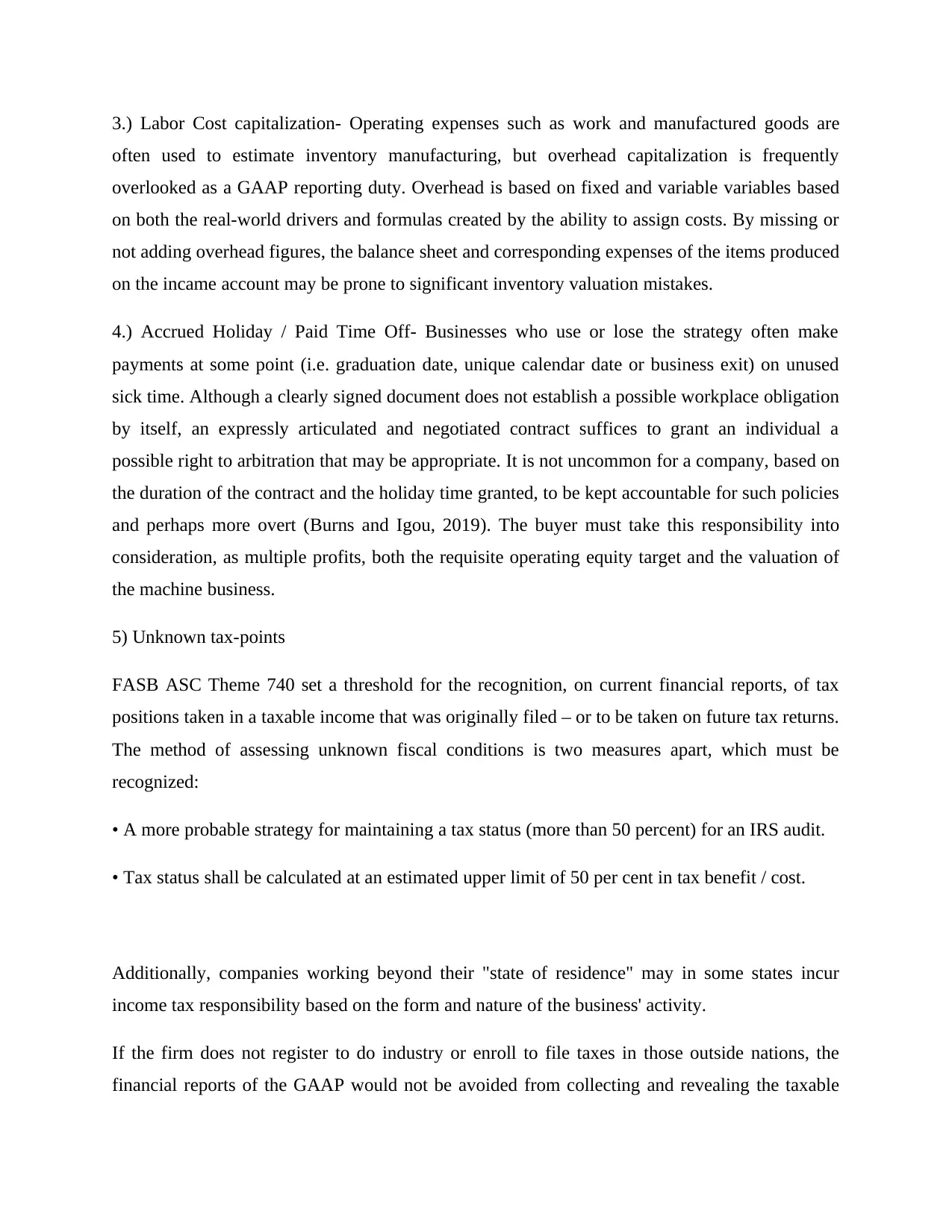
3.) Labor Cost capitalization- Operating expenses such as work and manufactured goods are
often used to estimate inventory manufacturing, but overhead capitalization is frequently
overlooked as a GAAP reporting duty. Overhead is based on fixed and variable variables based
on both the real-world drivers and formulas created by the ability to assign costs. By missing or
not adding overhead figures, the balance sheet and corresponding expenses of the items produced
on the incame account may be prone to significant inventory valuation mistakes.
4.) Accrued Holiday / Paid Time Off- Businesses who use or lose the strategy often make
payments at some point (i.e. graduation date, unique calendar date or business exit) on unused
sick time. Although a clearly signed document does not establish a possible workplace obligation
by itself, an expressly articulated and negotiated contract suffices to grant an individual a
possible right to arbitration that may be appropriate. It is not uncommon for a company, based on
the duration of the contract and the holiday time granted, to be kept accountable for such policies
and perhaps more overt (Burns and Igou, 2019). The buyer must take this responsibility into
consideration, as multiple profits, both the requisite operating equity target and the valuation of
the machine business.
5) Unknown tax-points
FASB ASC Theme 740 set a threshold for the recognition, on current financial reports, of tax
positions taken in a taxable income that was originally filed – or to be taken on future tax returns.
The method of assessing unknown fiscal conditions is two measures apart, which must be
recognized:
• A more probable strategy for maintaining a tax status (more than 50 percent) for an IRS audit.
• Tax status shall be calculated at an estimated upper limit of 50 per cent in tax benefit / cost.
Additionally, companies working beyond their "state of residence" may in some states incur
income tax responsibility based on the form and nature of the business' activity.
If the firm does not register to do industry or enroll to file taxes in those outside nations, the
financial reports of the GAAP would not be avoided from collecting and revealing the taxable
often used to estimate inventory manufacturing, but overhead capitalization is frequently
overlooked as a GAAP reporting duty. Overhead is based on fixed and variable variables based
on both the real-world drivers and formulas created by the ability to assign costs. By missing or
not adding overhead figures, the balance sheet and corresponding expenses of the items produced
on the incame account may be prone to significant inventory valuation mistakes.
4.) Accrued Holiday / Paid Time Off- Businesses who use or lose the strategy often make
payments at some point (i.e. graduation date, unique calendar date or business exit) on unused
sick time. Although a clearly signed document does not establish a possible workplace obligation
by itself, an expressly articulated and negotiated contract suffices to grant an individual a
possible right to arbitration that may be appropriate. It is not uncommon for a company, based on
the duration of the contract and the holiday time granted, to be kept accountable for such policies
and perhaps more overt (Burns and Igou, 2019). The buyer must take this responsibility into
consideration, as multiple profits, both the requisite operating equity target and the valuation of
the machine business.
5) Unknown tax-points
FASB ASC Theme 740 set a threshold for the recognition, on current financial reports, of tax
positions taken in a taxable income that was originally filed – or to be taken on future tax returns.
The method of assessing unknown fiscal conditions is two measures apart, which must be
recognized:
• A more probable strategy for maintaining a tax status (more than 50 percent) for an IRS audit.
• Tax status shall be calculated at an estimated upper limit of 50 per cent in tax benefit / cost.
Additionally, companies working beyond their "state of residence" may in some states incur
income tax responsibility based on the form and nature of the business' activity.
If the firm does not register to do industry or enroll to file taxes in those outside nations, the
financial reports of the GAAP would not be avoided from collecting and revealing the taxable
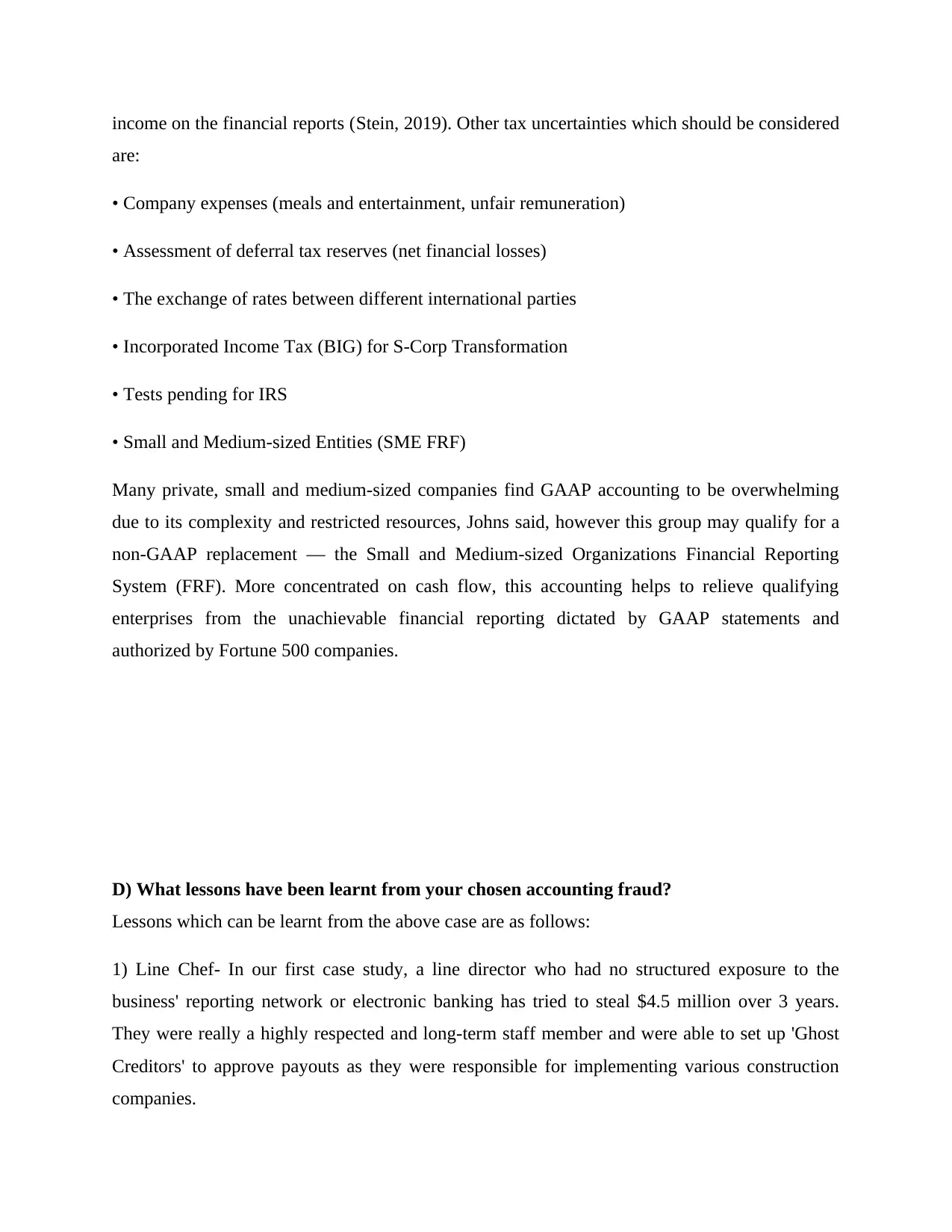
income on the financial reports (Stein, 2019). Other tax uncertainties which should be considered
are:
• Company expenses (meals and entertainment, unfair remuneration)
• Assessment of deferral tax reserves (net financial losses)
• The exchange of rates between different international parties
• Incorporated Income Tax (BIG) for S-Corp Transformation
• Tests pending for IRS
• Small and Medium-sized Entities (SME FRF)
Many private, small and medium-sized companies find GAAP accounting to be overwhelming
due to its complexity and restricted resources, Johns said, however this group may qualify for a
non-GAAP replacement — the Small and Medium-sized Organizations Financial Reporting
System (FRF). More concentrated on cash flow, this accounting helps to relieve qualifying
enterprises from the unachievable financial reporting dictated by GAAP statements and
authorized by Fortune 500 companies.
D) What lessons have been learnt from your chosen accounting fraud?
Lessons which can be learnt from the above case are as follows:
1) Line Chef- In our first case study, a line director who had no structured exposure to the
business' reporting network or electronic banking has tried to steal $4.5 million over 3 years.
They were really a highly respected and long-term staff member and were able to set up 'Ghost
Creditors' to approve payouts as they were responsible for implementing various construction
companies.
are:
• Company expenses (meals and entertainment, unfair remuneration)
• Assessment of deferral tax reserves (net financial losses)
• The exchange of rates between different international parties
• Incorporated Income Tax (BIG) for S-Corp Transformation
• Tests pending for IRS
• Small and Medium-sized Entities (SME FRF)
Many private, small and medium-sized companies find GAAP accounting to be overwhelming
due to its complexity and restricted resources, Johns said, however this group may qualify for a
non-GAAP replacement — the Small and Medium-sized Organizations Financial Reporting
System (FRF). More concentrated on cash flow, this accounting helps to relieve qualifying
enterprises from the unachievable financial reporting dictated by GAAP statements and
authorized by Fortune 500 companies.
D) What lessons have been learnt from your chosen accounting fraud?
Lessons which can be learnt from the above case are as follows:
1) Line Chef- In our first case study, a line director who had no structured exposure to the
business' reporting network or electronic banking has tried to steal $4.5 million over 3 years.
They were really a highly respected and long-term staff member and were able to set up 'Ghost
Creditors' to approve payouts as they were responsible for implementing various construction
companies.
⊘ This is a preview!⊘
Do you want full access?
Subscribe today to unlock all pages.

Trusted by 1+ million students worldwide
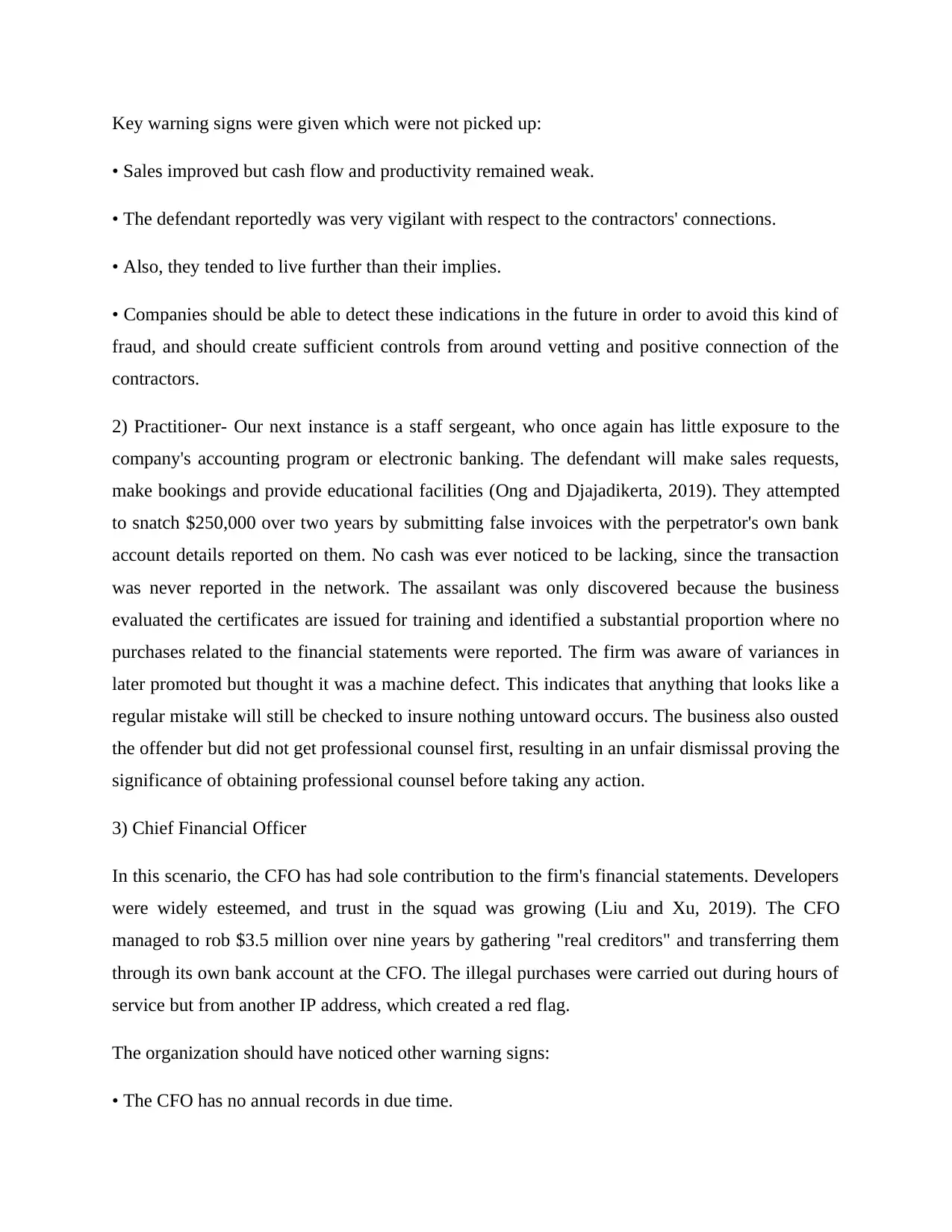
Key warning signs were given which were not picked up:
• Sales improved but cash flow and productivity remained weak.
• The defendant reportedly was very vigilant with respect to the contractors' connections.
• Also, they tended to live further than their implies.
• Companies should be able to detect these indications in the future in order to avoid this kind of
fraud, and should create sufficient controls from around vetting and positive connection of the
contractors.
2) Practitioner- Our next instance is a staff sergeant, who once again has little exposure to the
company's accounting program or electronic banking. The defendant will make sales requests,
make bookings and provide educational facilities (Ong and Djajadikerta, 2019). They attempted
to snatch $250,000 over two years by submitting false invoices with the perpetrator's own bank
account details reported on them. No cash was ever noticed to be lacking, since the transaction
was never reported in the network. The assailant was only discovered because the business
evaluated the certificates are issued for training and identified a substantial proportion where no
purchases related to the financial statements were reported. The firm was aware of variances in
later promoted but thought it was a machine defect. This indicates that anything that looks like a
regular mistake will still be checked to insure nothing untoward occurs. The business also ousted
the offender but did not get professional counsel first, resulting in an unfair dismissal proving the
significance of obtaining professional counsel before taking any action.
3) Chief Financial Officer
In this scenario, the CFO has had sole contribution to the firm's financial statements. Developers
were widely esteemed, and trust in the squad was growing (Liu and Xu, 2019). The CFO
managed to rob $3.5 million over nine years by gathering "real creditors" and transferring them
through its own bank account at the CFO. The illegal purchases were carried out during hours of
service but from another IP address, which created a red flag.
The organization should have noticed other warning signs:
• The CFO has no annual records in due time.
• Sales improved but cash flow and productivity remained weak.
• The defendant reportedly was very vigilant with respect to the contractors' connections.
• Also, they tended to live further than their implies.
• Companies should be able to detect these indications in the future in order to avoid this kind of
fraud, and should create sufficient controls from around vetting and positive connection of the
contractors.
2) Practitioner- Our next instance is a staff sergeant, who once again has little exposure to the
company's accounting program or electronic banking. The defendant will make sales requests,
make bookings and provide educational facilities (Ong and Djajadikerta, 2019). They attempted
to snatch $250,000 over two years by submitting false invoices with the perpetrator's own bank
account details reported on them. No cash was ever noticed to be lacking, since the transaction
was never reported in the network. The assailant was only discovered because the business
evaluated the certificates are issued for training and identified a substantial proportion where no
purchases related to the financial statements were reported. The firm was aware of variances in
later promoted but thought it was a machine defect. This indicates that anything that looks like a
regular mistake will still be checked to insure nothing untoward occurs. The business also ousted
the offender but did not get professional counsel first, resulting in an unfair dismissal proving the
significance of obtaining professional counsel before taking any action.
3) Chief Financial Officer
In this scenario, the CFO has had sole contribution to the firm's financial statements. Developers
were widely esteemed, and trust in the squad was growing (Liu and Xu, 2019). The CFO
managed to rob $3.5 million over nine years by gathering "real creditors" and transferring them
through its own bank account at the CFO. The illegal purchases were carried out during hours of
service but from another IP address, which created a red flag.
The organization should have noticed other warning signs:
• The CFO has no annual records in due time.
Paraphrase This Document
Need a fresh take? Get an instant paraphrase of this document with our AI Paraphraser
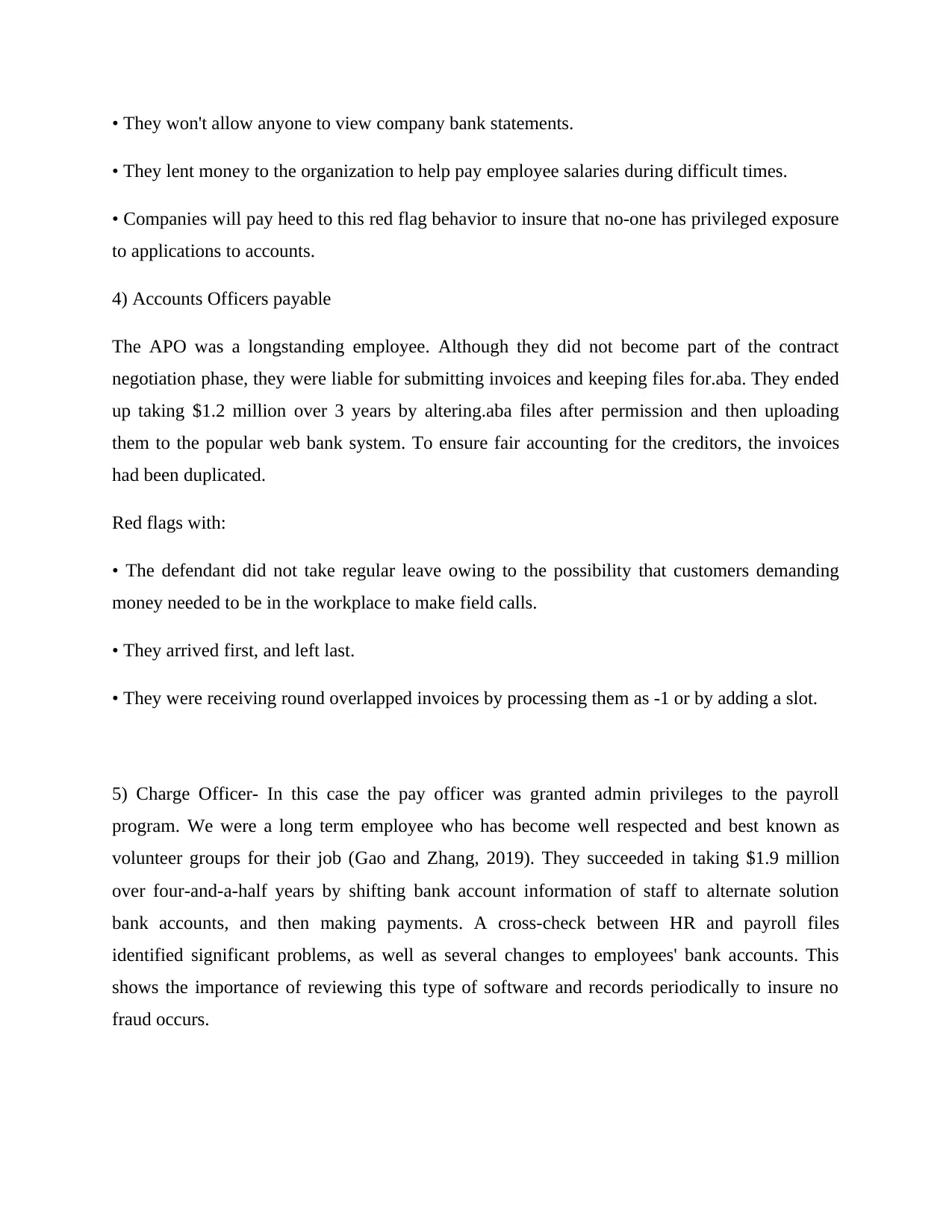
• They won't allow anyone to view company bank statements.
• They lent money to the organization to help pay employee salaries during difficult times.
• Companies will pay heed to this red flag behavior to insure that no-one has privileged exposure
to applications to accounts.
4) Accounts Officers payable
The APO was a longstanding employee. Although they did not become part of the contract
negotiation phase, they were liable for submitting invoices and keeping files for.aba. They ended
up taking $1.2 million over 3 years by altering.aba files after permission and then uploading
them to the popular web bank system. To ensure fair accounting for the creditors, the invoices
had been duplicated.
Red flags with:
• The defendant did not take regular leave owing to the possibility that customers demanding
money needed to be in the workplace to make field calls.
• They arrived first, and left last.
• They were receiving round overlapped invoices by processing them as -1 or by adding a slot.
5) Charge Officer- In this case the pay officer was granted admin privileges to the payroll
program. We were a long term employee who has become well respected and best known as
volunteer groups for their job (Gao and Zhang, 2019). They succeeded in taking $1.9 million
over four-and-a-half years by shifting bank account information of staff to alternate solution
bank accounts, and then making payments. A cross-check between HR and payroll files
identified significant problems, as well as several changes to employees' bank accounts. This
shows the importance of reviewing this type of software and records periodically to insure no
fraud occurs.
• They lent money to the organization to help pay employee salaries during difficult times.
• Companies will pay heed to this red flag behavior to insure that no-one has privileged exposure
to applications to accounts.
4) Accounts Officers payable
The APO was a longstanding employee. Although they did not become part of the contract
negotiation phase, they were liable for submitting invoices and keeping files for.aba. They ended
up taking $1.2 million over 3 years by altering.aba files after permission and then uploading
them to the popular web bank system. To ensure fair accounting for the creditors, the invoices
had been duplicated.
Red flags with:
• The defendant did not take regular leave owing to the possibility that customers demanding
money needed to be in the workplace to make field calls.
• They arrived first, and left last.
• They were receiving round overlapped invoices by processing them as -1 or by adding a slot.
5) Charge Officer- In this case the pay officer was granted admin privileges to the payroll
program. We were a long term employee who has become well respected and best known as
volunteer groups for their job (Gao and Zhang, 2019). They succeeded in taking $1.9 million
over four-and-a-half years by shifting bank account information of staff to alternate solution
bank accounts, and then making payments. A cross-check between HR and payroll files
identified significant problems, as well as several changes to employees' bank accounts. This
shows the importance of reviewing this type of software and records periodically to insure no
fraud occurs.
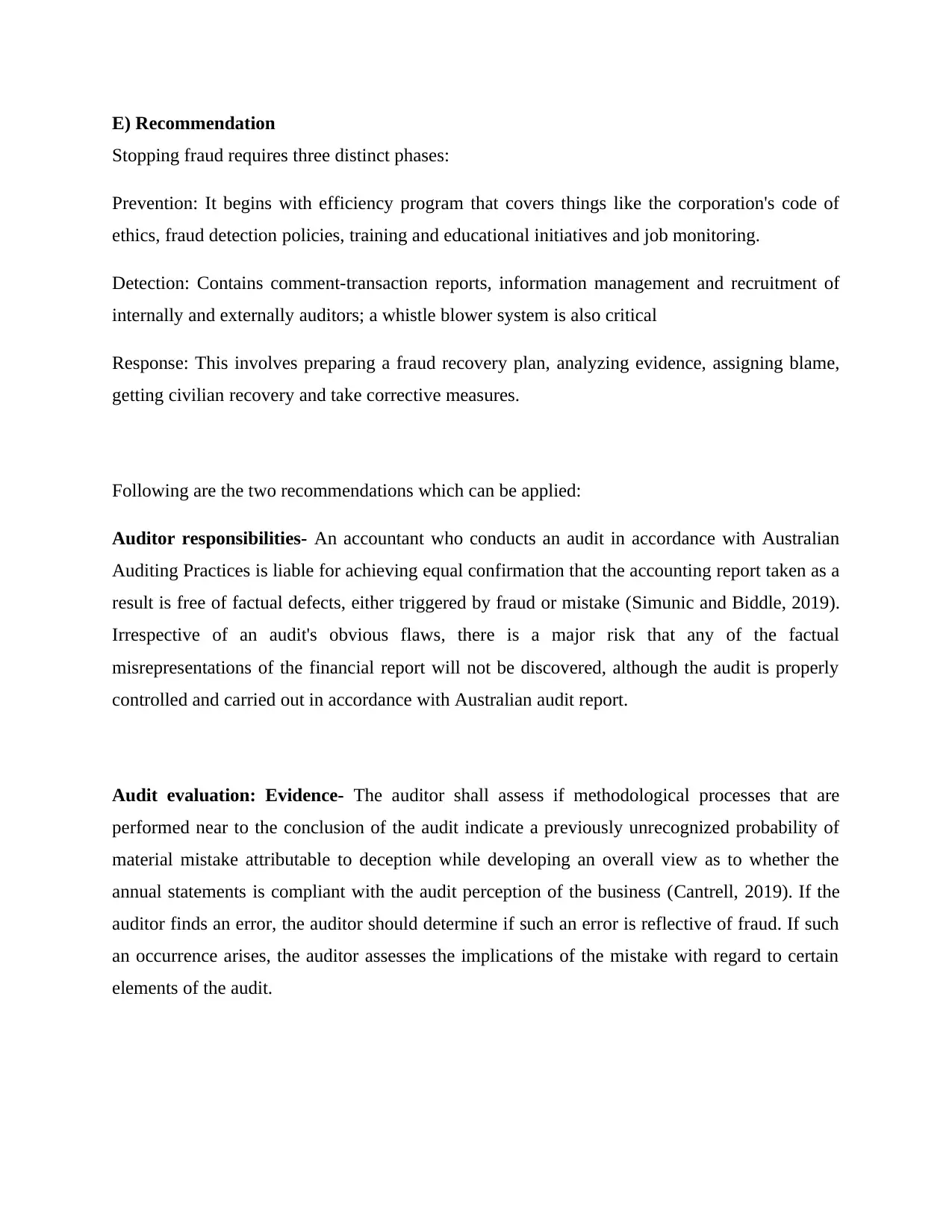
E) Recommendation
Stopping fraud requires three distinct phases:
Prevention: It begins with efficiency program that covers things like the corporation's code of
ethics, fraud detection policies, training and educational initiatives and job monitoring.
Detection: Contains comment-transaction reports, information management and recruitment of
internally and externally auditors; a whistle blower system is also critical
Response: This involves preparing a fraud recovery plan, analyzing evidence, assigning blame,
getting civilian recovery and take corrective measures.
Following are the two recommendations which can be applied:
Auditor responsibilities- An accountant who conducts an audit in accordance with Australian
Auditing Practices is liable for achieving equal confirmation that the accounting report taken as a
result is free of factual defects, either triggered by fraud or mistake (Simunic and Biddle, 2019).
Irrespective of an audit's obvious flaws, there is a major risk that any of the factual
misrepresentations of the financial report will not be discovered, although the audit is properly
controlled and carried out in accordance with Australian audit report.
Audit evaluation: Evidence- The auditor shall assess if methodological processes that are
performed near to the conclusion of the audit indicate a previously unrecognized probability of
material mistake attributable to deception while developing an overall view as to whether the
annual statements is compliant with the audit perception of the business (Cantrell, 2019). If the
auditor finds an error, the auditor should determine if such an error is reflective of fraud. If such
an occurrence arises, the auditor assesses the implications of the mistake with regard to certain
elements of the audit.
Stopping fraud requires three distinct phases:
Prevention: It begins with efficiency program that covers things like the corporation's code of
ethics, fraud detection policies, training and educational initiatives and job monitoring.
Detection: Contains comment-transaction reports, information management and recruitment of
internally and externally auditors; a whistle blower system is also critical
Response: This involves preparing a fraud recovery plan, analyzing evidence, assigning blame,
getting civilian recovery and take corrective measures.
Following are the two recommendations which can be applied:
Auditor responsibilities- An accountant who conducts an audit in accordance with Australian
Auditing Practices is liable for achieving equal confirmation that the accounting report taken as a
result is free of factual defects, either triggered by fraud or mistake (Simunic and Biddle, 2019).
Irrespective of an audit's obvious flaws, there is a major risk that any of the factual
misrepresentations of the financial report will not be discovered, although the audit is properly
controlled and carried out in accordance with Australian audit report.
Audit evaluation: Evidence- The auditor shall assess if methodological processes that are
performed near to the conclusion of the audit indicate a previously unrecognized probability of
material mistake attributable to deception while developing an overall view as to whether the
annual statements is compliant with the audit perception of the business (Cantrell, 2019). If the
auditor finds an error, the auditor should determine if such an error is reflective of fraud. If such
an occurrence arises, the auditor assesses the implications of the mistake with regard to certain
elements of the audit.
⊘ This is a preview!⊘
Do you want full access?
Subscribe today to unlock all pages.

Trusted by 1+ million students worldwide
1 out of 14
Related Documents
Your All-in-One AI-Powered Toolkit for Academic Success.
+13062052269
info@desklib.com
Available 24*7 on WhatsApp / Email
![[object Object]](/_next/static/media/star-bottom.7253800d.svg)
Unlock your academic potential
Copyright © 2020–2025 A2Z Services. All Rights Reserved. Developed and managed by ZUCOL.





